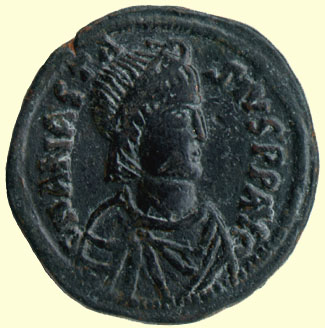 Contents -
Previous Article -
Next Article
Contents -
Previous Article -
Next Article
At the time of the death of Zeno, Anastasius was a sixty - one year old usher at the imperial palace at Constantinople. Ariadne, Zeno's widow, selected him to succeed to the throne. A few weeks later, Ariadne married him.
Anastasius was a good administrator and built up the treasury while bringing tax relief to the people. He repealed the tax on professions which was bringing about the ruin of many small businessmen. Any person, prostitutes included, who was engaged in a business or profession had to pay this tax and it was universally dreaded. He also reformed the tax on farm production, making it payable in gold instead of in agricultural products (in kind). His careful fiscal policy left 520,000 pounds of gold in the treasury at the time of his death.
Constantinople at that time was not a place where religious tolerance flourished, even amongst different sects of Christians. Despite having been persecuted for centuries, the Church that existed two hundred years after Constantine the Great issued the Edict of Milan was not very tolerant of differences. Anastasius did not hold true with every element of orthodox dogma and there was frequent rioting in the streets because of this.
In 498, Anastasius reformed the money system. While the gold solidus was very popular throughout the Byzantine world and Western Europe, the small, aspirin tablet sized bronze coins were not very suitable as currency and were easily lost. Anastasius introduced a large copper coin with a diameter of 35 to 40 millimeters. The piece was valued at 40 nummia (a unit of money) and smaller pieces of 20, 10, and 5 nummia were struck in this and later reigns. Before these reforms, the bronze coins had no fixed value in relation to the gold. In other words, one could not say that a gold solidus was worth so many small bronze pieces. The common people were left at the mercy of the money - changers and the government, who could and often did give differing quantities of the small bronze in exchange for the gold. The government would not even accept its own bronze coins in payment of taxes, and would only accept gold solidi by weight instead of face value. This, of course, caused people to lose confidence in the buying power of the bronze coins until Anastasius gave them a fixed value in relationship to gold.
Anastasius died in 518 after a reign of twenty - seven years and was succeeded by Justin, a former army officer of peasant ancestry who had risen to command the palace guard.
Go to next article on Justin I
Go back to previous article on Zeno